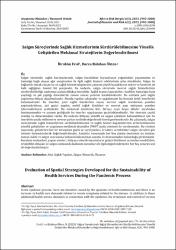| dc.contributor.author | Erol, İbrahim | |
| dc.contributor.author | Balaban Ökten, Burcu | |
| dc.date.accessioned | 2024-01-12T18:55:09Z | |
| dc.date.available | 2024-01-12T18:55:09Z | |
| dc.date.issued | 2023 | en_US |
| dc.identifier.issn | 2636-8390 | |
| dc.identifier.uri | https://hdl.handle.net/11363/6937 | |
| dc.description.abstract | Salgın sürecinde, sağlık kuruluşlarında, salgın hastalıktan kaynaklanan yoğunluklar yaşanmakta ve
hastalığa bağlı oluşan ağır semptomlar ile ilgili sağlık hizmeti taleblerinde artış olmaktadır. Salgın ile
bağlantılı olarak oluşan bu ek sağlık hizmet taleplerinin yanısıra çeşitli hastalıkların tedavi ve kontrolü de
halk sağlığının önemli bir parçasıdır. Bu nedenle, salgın sürecinde mevcut sağlık hizmetlerinin
sürdürülebilirliği, toplumsal açıdan oldukça önemlidir. Sağlık hizmet kapasiteleri, özellikle hastalığın hızla
yayıldığı ve pik yaptığı dönemlerde zaman zaman yetersiz kalabilmektedir. Bu noktada yeni sağlık
yapılarına ihtiyaç duyulmaktadır. Alanda yapılan çalışmalar ve uygulamalar bu konuda farklı önerilerde
bulunmaktadır. Bu öneriler, yeni sağlık tesislerinin inşası, mevcut sağlık tesislerinin yeniden
yapılandırılması, acil geçici yapılar, mobil sağlık klinikleri ve mevcut yapı stokunun yeniden
işlevlendirilmesi şeklindedir. Bu mekansal önerilerin biri, birkaçı veya hepsi ülkeler tarafından
benimsenmekte ve zamanı geldiğinde bu öneriler uygulamaya geçirilebilmektedir. Her önerinin çeşitli
avantaj ve dezavantajları vardır. Bu nedenle ihtiyaca yönelik en uygun çözümün bulunabilmesi için bu
önerilerin analiz edilmesi ve mevcut şartlar özelinde değerlendirilmesi gerekmektedir. Bu çalışmada, salgın
süreçlerinde sağlık hizmetlerinin sürdürülebilmesine ve sağlık hizmet kapasitelerinin arttırılabilmesine
yönelik geliştirilen ve uygulanan mekânsal stratejiler SWOT analiz yöntemi ile incelenmiştir. Bu yöntem
sayesinde, geliştirilen her bir stratejinin güçlü ve zayıf yönleri, fırsatları ve tehditleri salgın süreçleri göz
önünde bulundurularak değerlendirilmiştir. Analizler sonucunda her beş çözüm önerisinin de maliyet,
zaman, kalite ve salgın sonrasında kullanım bakımından avantaj ve dezavantajları bulunduğu görülmüştür.
Kurulum maliyetleri, yapım süreleri, ihtiyaca yönelik tasarımların geliştirilebilmesi açısından esneklikleri,
erişilebilir olmaları ve salgın sonrasında kullanım durumları ile ilgili değerlendirmeler her beş senaryo için
de değerlendirilmiştir. | en_US |
| dc.description.abstract | In the epidemic process, there are densities caused by the epidemic in health institutions and there is an
increase in health care demands related to severe symptoms related to the disease. In addition to these
additional health service demands in connection with the epidemic, the treatment and control of various diseases is also an significant part of public health. For this reason, the sustainability of existing health
services during the epidemic is very important from a social point of view. Health service capacities may be
insufficient from time to time, especially during periods when the disease spreads rapidly and peaks. At this
point, new health structures are needed. Studies and applications in the field offer different suggestions on
this subject. These suggestions are the construction of new health facilities, restructuring of existing health
facilities, emergency temporary structures, mobile health clinics and re-functioning of the existing building
stock. One, more or all of these spatial suggestions are adopted by the countries and these suggestions can
be put into practice when the time comes. Each proposal has several advantages and disadvantages. For this
reason, these suggestions should be analyzed and evaluated in terms of current conditions in order to find
the most appropriate solution for the need. In this study, spatial strategies developed and applied to
maintain health services and increase health service capacities during epidemic processes were examined
by SWOT analysis method. Through this method, the strengths and weaknesses, opportunities and threats
of each developed strategy were evaluated by considering the epidemic processes. As a result of the
analyzes, it has been seen that all five solution proposals have advantages and disadvantages in terms of
cost, time, quality and use after the epidemic. Evaluations regarding installation costs, construction times,
flexibility in terms of developing customized designs, accessibility and post-pandemic use cases were
evaluated for all five scenarios. | en_US |
| dc.language.iso | tur | en_US |
| dc.publisher | Ankara Üniversitesi | en_US |
| dc.relation.isversionof | 10.35341/afet.1256484 | en_US |
| dc.rights | info:eu-repo/semantics/openAccess | en_US |
| dc.subject | Afet | en_US |
| dc.subject | Sağlık Yapıları | en_US |
| dc.subject | Salgın | en_US |
| dc.subject | Mimarlık | en_US |
| dc.subject | Tasarım | en_US |
| dc.subject | Disaster | en_US |
| dc.subject | Healthcare Buildings | en_US |
| dc.subject | Pandemic | en_US |
| dc.subject | Architecture | en_US |
| dc.subject | Design | en_US |
| dc.title | Salgın Süreçlerinde Sağlık Hizmetlerinin Sürdürülebilmesine Yönelik Geliştirilen Mekânsal Stratejilerin Değerlendirilmesi | en_US |
| dc.title.alternative | Evaluation of Spatial Strategies Developed for the Sustainability of Health Services During the Pandemic Process | en_US |
| dc.type | article | en_US |
| dc.relation.ispartof | Afet ve Risk Dergisi | en_US |
| dc.department | Güzel Sanatlar Fakültesi | en_US |
| dc.authorid | 0000-0002-3092-7128 | en_US |
| dc.authorid | 0000-0001-6916-8475 | en_US |
| dc.identifier.volume | 6 | en_US |
| dc.identifier.issue | 3 | en_US |
| dc.identifier.startpage | 992 | en_US |
| dc.identifier.endpage | 1008 | en_US |
| dc.relation.publicationcategory | Makale - Ulusal Hakemli Dergi - Kurum Öğretim Elemanı | en_US |
| dc.contributor.institutionauthor | Erol, İbrahim | |

















